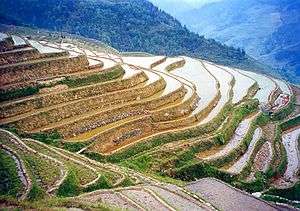Miao people
The Miao are a minority ethnic group living in southern China, and is recognized by the government of China as one of the 56 official ethnic groups. Miao is a Chinese term, while the component groups of people, which include (with some variant spellings) Hmong, Hmu, Xong (Qo-Xiong), and A-Hmao, may have their own self-designations.
Hmongb / Hmub / Xongb / ab Hmaob m̥oŋ˦˧ / m̥ʰu˧ / ɕoŋ˧˥ / a˥˧m̥ao˥˧ | |
|---|---|
 Headdress of the Long-horn Miao—one of the small branches of Miao living in the 12 villages near Zhijin County, Guizhou | |
| Total population | |
| 11–12 million | |
| Regions with significant populations | |
| 9,426,007 (2010) | |
| 1,068,189 (2009) | |
| 595,028 (2015) | |
| 247,595 (2010)[1] | |
| 151,080 (2002) | |
| 13,000 | |
| 2,190[2] | |
| Languages | |
| Hmongic languages, Mandarin, Cantonese, Vietnamese, Tai-Kadai languages (Lao and Thai), French | |
| Religion | |
| Miao folk religion. Minorities: Taoism, Atheism, Irreligion, Christianity, Buddhism | |
| Miao people | |||||||||||||||||||||||||
|---|---|---|---|---|---|---|---|---|---|---|---|---|---|---|---|---|---|---|---|---|---|---|---|---|---|
| Chinese | 苗族 | ||||||||||||||||||||||||
| |||||||||||||||||||||||||
The different peoples in the "Miao" group may not necessarily be either linguistically or culturally related, though the majority are members of Miao-Yao language family, which includes the Hmong, Hmub, Xong and A-Hmao and the majority do share cultural similarities. Many Miao groups cannot communicate with each other in their native tongues and have different histories and cultures. Many groups designated as Miao do not even agree that they belong to the ethnic group, though some Miao groups, such as the Hmong do agree with the collective grouping as a single ethnic group – Miao.
The Miao live primarily in southern China's mountains, in the provinces of Guizhou, Yunnan, Sichuan, Hubei, Hunan, Guangxi, Guangdong and Hainan. Some sub-groups of the Miao, most notably the Hmong people, have migrated out of China into Southeast Asia (Burma (Myanmar), northern Vietnam, Laos and Thailand). Following the communist takeover of Laos in 1975, a large group of Hmong refugees resettled in several Western nations, mainly in the United States, France, and Australia.
Nomenclature: Miao or Hmong
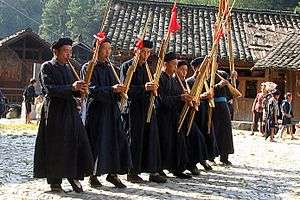
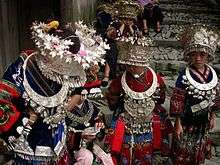
.jpg)
The term "Miao" gained official status in 1949 as a minzu (ethnic group) encompassing a group of linguistically-related ethnic minorities in Southwest China. This was part of a larger effort to identify and classify minority groups to clarify their role in the national government, including establishing autonomous administrative divisions and allocating the seats for representatives in provincial and national government.[3]
Historically, the term "Miao" had been applied inconsistently to a variety of non-Han peoples. Early Chinese-based names use various transcriptions: Miao, Miao-tse, Miao-tsze, Meau, Meo, mo, Miao-tseu etc. In Southeast Asian contexts, words derived from the Chinese "Miao" took on a sense which was perceived as derogatory by the subgroups living in that region. The term re-appeared in the Ming dynasty (1368–1644), by which time it had taken on the connotation of "barbarian." Being a variation of Nanman, it was used to refer to the indigenous people in southern China who had not been assimilated into Han culture. During this time, references to Unfamiliar (生 Sheng) and Familiar (熟 Shu) Miao appear, referring to the level of assimilation and political cooperation of the two groups, making them easier to classify. Not until the Qing dynasty (1644–1911) do more finely grained distinctions appear in writing. Even then, discerning which ethnic groups are included in various classifications can be complex. There has been a historical tendency by the Hmong, who resisted assimilation and political cooperation, to group all Miao peoples together under the term Hmong because of the potential derogatory use of the term Miao. In modern China, however, the term continues to be used regarding the Miao people there.[4]
Though the Miao themselves use various self-designations, the Chinese traditionally classify them according to the most characteristic color of the women's clothes. The list below contains some of these self-designations, the color designations, and the main regions inhabited by the four major groups of Miao in China:
- Ghao Xong/Qo Xiong; Xong; Red Miao; Qo Xiong Miao: west Hunan
- Gha Ne/Ka Nao; Hmub; Black Miao; Mhub Miao: southeast Guizhou
- A-Hmao; Big Flowery Miao: west Guizhou and northeast Yunnan
- Gha-Mu; Hmong, Mong; White Miao, Green/Blue Miao, Small Flowery Miao; south and east Yunnan, south Sichuan and west Guizhou
Demographics

According to the 2000 census, the number of Miao in China was estimated to be about 9.6 million. Outside of China, members of the Miao sub-group or nations of the Hmong live in Thailand, Laos, Vietnam and Burma due to outward migrations starting in the 18th century. As a result of recent migrations in the aftermath of the Indochina and Vietnam Wars from 1949–75, many Hmong people now live in the United States, French Guiana, France and Australia. Altogether, there are approximately 10 million speakers in the Miao language family. This language family, which consists of 6 languages and around 35 dialects (some of which are mutually intelligible) belongs to the Hmong/Miao branch of the Hmong–Mien (Miao–Yao) language family.
A large population of the Hmong have emigrated to the northern mountainous reaches of Southeast Asia including Thailand, Laos, Vietnam, and Burma. However, many continue to live in far Southwest China mostly in the provinces of Yunnan, Guangxi, and to a very limited extent in Guizhou.
- Note: The Miao areas of Sichuan province became part of the newly created Chongqing Municipality in 1997.
Most Miao currently live in China. Miao population growth in China:
- 1953: 2,510,000
- 1964: 2,780,000
- 1982: 5,030,000
- 1990: 7,390,000
3,600,000 Miao, about half of the entire Chinese Miao population, were in Guizhou in 1990. The Guizhou Miao and those in the following six provinces make up over 98% of all Chinese Miao:
- Hunan: 1,550,000
- Yunnan: 890,000
- Sichuan: 530,000
- Guangxi: 420,000
- Hubei: 200,000
- Hainan: 50,000 (known as Miao but ethnically Yao and Li)
In the above provinces, there are 6 Miao autonomous prefectures (shared officially with one other ethnic minority):
- Qiandongnan Miao and Dong Autonomous Prefecture, Guizhou
- Qiannan Buyei and Miao Autonomous Prefecture, Guizhou
- Qianxinan Buyei and Miao Autonomous Prefecture, Guizhou
- Xiangxi Tujia and Miao Autonomous Prefecture, Hunan
- Wenshan Zhuang and Miao Autonomous Prefecture, Yunnan
- Enshi Tujia and Miao Autonomous Prefecture, Hubei
There are in addition 23 Miao autonomous counties:
- Hunan: Mayang, Jingzhou, Chengbu
- Guizhou: Songtao, Yinjiang, Wuchuan, Daozhen, Zhenning, Ziyun, Guanling, Weining
- Yunnan: Pingbian, Jinping, Luquan
- Chongqing: Xiushan, Youyang, Qianjiang, Pengshui
- Guangxi: Rongshui, Longsheng, Longlin (including Hmong)
- Hainan: Qiongzhong and Baoting
Most Miao reside in hills or on mountains, such as
- Wuling Mountain by the Qianxiang River (湘黔川边的武陵山; Xiāngqián Chuān Biān Dí Wǔlíng Shān)
- Miao Mountain (苗岭; Miáo Líng), Qiandongnan
- Yueliang Mountain (月亮山; Yuèliàng Shān), Qiandongnan
- Greater and Lesser Ma Mountain (大小麻山; Dà Xiǎo Má Shān), Qiannan
- Greater Miao Mountain (大苗山; Dà Miáo Shān), Guangxi
- Wumeng Mountain by the Tianqian River (滇黔川边的乌蒙山; Tiánqián Chuān Biān Dí Wūmēng Shān)
Several thousands of Miao left their homeland to move to larger cities like Guangzhou and Beijing. There are 789,000 Hmong spread throughout northern Vietnam, Laos, Burma, and on other continents. 174,000 live in Thailand, where they are one of the six main hill tribes.
 Young ethnic Miao boy in Guizhou
Young ethnic Miao boy in Guizhou Traditional Miao Boat used to travel down rapids for trading goods.
Traditional Miao Boat used to travel down rapids for trading goods. Traditional Miao irrigation system made entirely of wood planks (Yunnan Province)
Traditional Miao irrigation system made entirely of wood planks (Yunnan Province)
History
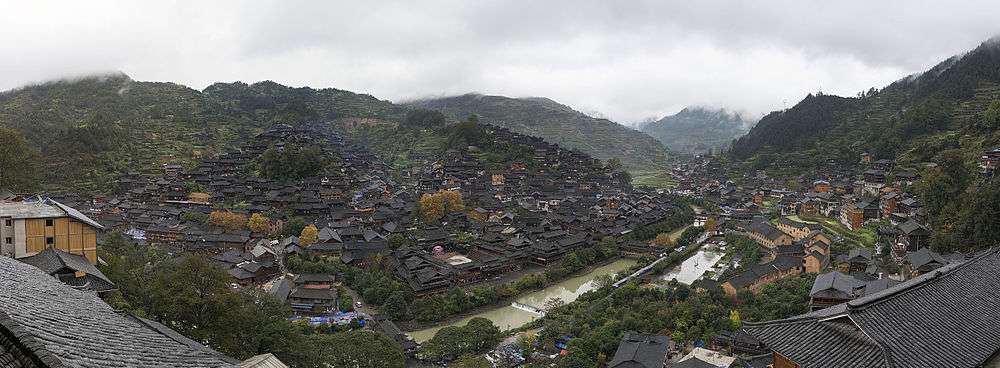
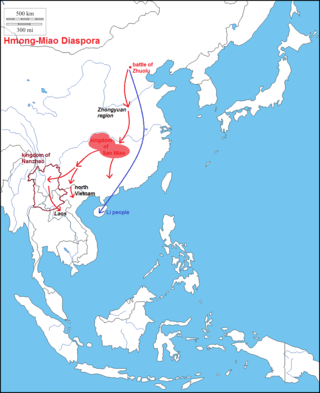
Legend of Chiyou
According to Chinese legend, the Miao who descended from the Jiuli tribe led by Chiyou (Chinese: 蚩尤; pinyin: Chīyóu) were defeated at the Battle of Zhuolu (涿鹿; Zhuōlù, a defunct prefecture on the border of present provinces of Hebei and Liaoning) by the military coalition of Huang Di (黃帝; Huángdì) and Yan Di, leaders of the Huaxia (華夏; Huáxià) tribe as the two tribes struggled for supremacy of the Yellow River valley.
Archaeological discoveries
According to André-Georges Haudricourt and David Strecker's claims based on limited secondary data, the Miao were among the first people to settle in present-day China.[6] They claim that the Han borrowed a lot of words from the Miao in regard to rice farming. This indicated that the Miao were among the first rice farmers in China. In addition, some have connected the Miao to the Daxi Culture (5,300 – 6,000 years ago) in the middle Yangtze River region.[7] The Daxi Culture has been credited with being amongst the first cultivators of rice in the Far East by Western scholars. However, in 2006 rice cultivation was found to have existed in the Shandong province even earlier than the Daxi Culture.[8] Though the Yuezhuang culture has cultivated rice, it is more of collected wild rice and not actual cultivated and domesticated rice like that of the Daxi.
A western study mention that the Miao (especially the Miao-Hunan) have some DNA from the Northeast people of China, but has origins in southern china. Recent DNA samples of Miao males contradict this theory. The White Hmong have 25% C, 8% D, & 6% N(Tat)[9] yet they have the least contact with the Han population.
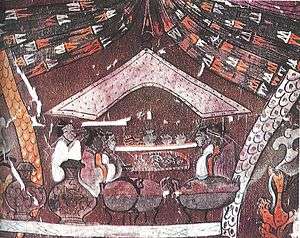
Chu
In 2002, the Chu language has been identified as perhaps having influence from Tai–Kam and Miao–Yao languages by researchers at University of Massachusetts Amherst.[10]
Qin and Han dynasties
The term Miao was first used by the Han Chinese in pre-Qin times (in other words, before 221 BC) for designating non-Han Chinese groups in the south. It was often used in combination: "nanmiao", "miaomin", "youmiao" and "Three Miaos" (三苗; Sānmiáo)
Ming and Qing dynasties
During the Ming and Qing dynasties (1368–1911) 'miao' and 'man' were both used, the second possibly to designate the Yao (傜; Yáo) people. The Yuan, Ming, and Qing Dynasties could neither fully assimilate nor control the indigenous people.
During the Miao Rebellions, when Miao tribes rebelled, Ming troops, including Han Chinese, Hui people, crushed the rebels, killing thousands of them.[11][12] Mass castrations of Miao boys also took place.[13]
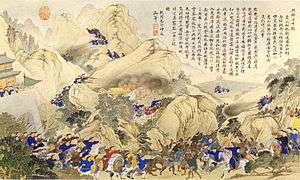
During the Qing Dynasty the Miao fought three wars against the empire.[14] The issue was so serious that the Yongzheng emperor sent one of his most officials, Ortai, to be the Viceroy of the provinces with significant Miao populations in 1726, and through 1731, he spent his time putting down rebellions.[15] In 1735 in the southeastern province of Guizhou, the Miao rose up against the government's forced assimilation. Eight counties involving 1,224 villages fought until 1738 when the revolt ended. According to Xiangtan University Professor Wu half the Miao population were affected by the war.
The second war (1795–1806) involved the provinces of Guizhou and Hunan. Shi Sanbao and Shi Liudeng led this second revolt. Again, it ended in failure, but it took 11 years to quell the uprising.[16]
The greatest of the three wars occurred from 1854 to 1873. Zhang Xiu-mei led this revolt in Guizhou until his capture and death in Changsha, Hunan. This revolt affected over one million people and all the neighbouring provinces. By the time the war ended Professor Wu said only 30 percent of the Miao were left in their home regions. This defeat led to the Hmong people migrating out of China.
During Qing times, more military garrisons were established in southwest China. Han Chinese soldiers moved into the Taijiang region of Guizhou, married Miao women, and the children were brought up as Miao.[17][18] In spite of rebellion against the Han, Hmong leaders made allies with Han merchants.[19]
The imperial government had to rely on political means to bring in Hmong people into the government: they created multiple competing positions of substantial prestige for Miao people to participate and assimilate into the Qing government system. During the Ming and Qing times, the official position of Kiatong was created in Indochina. The Miao would employ the use of the Kiatong government structure until the 1900s when they entered into French colonial politics in Indochina.
20th century
During the founding of the People's Republic of China (PRC), the Miao played an important role in its birth when they helped Mao Zedong to escape the Kuomintang in the Long March with supplies and guides through their territory.
In Vietnam, a powerful Hmong named Vuong Chinh Duc, dubbed the king of the Hmong, aided Ho Chi Minh's nationalist move against the French, and thus secured the Hmong's position in Vietnam.[20] During the Vietnam War, Miao fought on both sides, the Hmong in Laos primarily for the US, across the border in Vietnam for the North-Vietnam coalition, the Chinese-Miao for the Communists. However, after the war the Vietnamese were very aggressive towards the Hmong who suffered many years of reprisals and genocide. Most Hmong in Thailand also supported a brief Communist uprising during the war.
Miao clans with Han origins
Some of the origins of the Hmong and Miao clan names are a result of the marriage of Hmong women to Han Chinese men,[21][22] with distinct Han Chinese-descended clans and lineages practicing Han Chinese burial customs.[23] These clans were called "Han Chinese Hmong" ("Hmong Sua") in Sichuan, and were instructed in military tactics by fugitive Han Chinese rebels.[24] Such Chinese "surname groups" are comparable to the patrilineal Hmong clans and also practice exogamy.[25][26][27][28][29]
Han Chinese male soldiers who fought against the Miao rebellions during the Qing and Ming dynasties were known to have married with non-Han women such as the Miao because Han women were less desirable.[30][31][32] The Wang clan, founded among the Hmong in Gongxian county of Sichuan's Yibin district, is one such clan and can trace its origins to several such marriages around the time of the Ming dynasty suppression of the Ah rebels.[33] Nicholas Tapp wrote that, according to The Story of the Ha Kings in the village, one such Han ancestor was Wang Wu.[34] It is also noted that the Wang typically sided with the Chinese, being what Tapp calls "cooked" as opposed to the "raw" peoples who rebelled against the Chinese.[35][33]
Hmong women who married Han Chinese men founded a new Xem clan among Northern Thailand's Hmong. Fifty years later in Chiangmai two of their Hmong boy descendants were Catholics.[36] A Hmong woman and Han Chinese man married and founded northern Thailand's Lau2, or Lauj, clan, [36], with another Han Chinese man of the family name Deng founding another Hmong clan. Some scholars believe this lends further credence to the idea that some or all of the present day Hmong clans were formed in this way.[37]
Jiangxi Han Chinese are claimed by some as the forefathers of the southeast Guizhou Miao, and Miao children were born to the many Miao women married Han Chinese soldiers in Taijiang in Guizhou before the second half of the 19th century.[38]
Some imperially commissioned Han Chinese chieftaincies assimilated with the Miao. Those became the ancestors of a part of the Miao population in Guizhou.[39]
The Hmong Tian clan in Sizhou began in the seventh century as a migrant Han Chinese clan.[40]
The origin of the Tunbao people traces back to the Ming dynasty when the Hongwu Emperor sent 300,000 Han Chinese male soldiers in 1381 to conquer Yunnan, with some of the men marrying Yao and Miao women.[41][42]
The presence of women presiding over weddings was a feature noted in "Southeast Asian" marriages, such as in 1667 when a Miao woman in Yunnan married a Chinese official.[43] Some Sinicization occurred, in Yunnan a Miao chief's daughter married a scholar in the 1600s who wrote that she could read, write, and listen in Chinese and read Chinese classics.[44]
Distribution
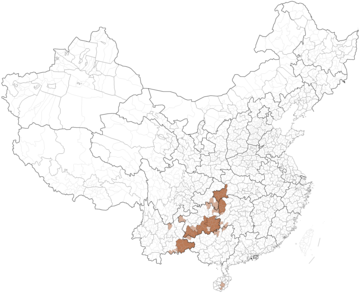 Miao autonomous prefectures and counties in China
Miao autonomous prefectures and counties in China Map of Hmong-Mien languages distribution
Map of Hmong-Mien languages distribution
By province
The 2000 Chinese census recorded 8,940,116 Miao in mainland China.
- Provincial distribution of the Miao in mainland China
| Province-level division | % of mainland China's Miao population | % of provincial total |
|---|---|---|
| Guizhou Province | 48.10% | 12.199% |
| Hunan Province | 21.49% | 3.037% |
| Yunnan Province | 11.67% | 2.463% |
| Chongqing Municipality | 5.62% | 1.647% |
| Guangxi Zhuang Autonomous Region | 5.18% | 1.056% |
| Hubei Province | 2.40% | 0.360% |
| Sichuan Province | 1.65% | 0.179% |
| Guangdong Province | 1.35% | 0.142% |
| Hainan Province | 0.69% | 0.810% |
| Others | 1.85% | N/A |
By county
- County-level distribution of the Miao in mainland China
(Only includes counties or county-equivalents containing >0.25% of mainland China's Miao population.)
| Province-level division | Prefecture-level division | County-level division | Miao population | % of mainland China's Miao population |
|---|---|---|---|---|
| Guizhou | Qiandongnan Miao and Dong A. P. | Kaili City (凯里市) | 274,238 | 3.07% |
| Chongqing Municipality | none | Pengshui Miao and Tujia A. C. (彭水苗族土家族自治县) | 273,488 | 3.06% |
| Hunan | Huaihua City | Mayang Miao A. C. (麻阳苗族自治县) | 263,437 | 2.95% |
| Guizhou | Tongren City | Songtao Miao A. C. (松桃苗族自治县) | 228,718 | 2.56% |
| Hunan | Huaihua City | Yuanling County (沅陵县) | 217,613 | 2.43% |
| Hunan | Xiangxi Tujia and Miao A. P. | Huayuan County (花垣县) | 192,138 | 2.15% |
| Hunan | Xiangxi Tujia and Miao A. P. | Fenghuang County (凤凰县) | 185,111 | 2.07% |
| Hunan | Shaoyang City | Suining County (绥宁县) | 184,784 | 2.07% |
| Guangxi Zhuang A. R. | Liuzhou City | Rongshui Miao A. C. (融水苗族自治县) | 168,591 | 1.89% |
| Guizhou | Qiandongnan Miao and Dong A. P. | Huangping County (黄平县) | 161,211 | 1.8% |
| Guizhou | Zunyi City | Wuchuan Gelao and Miao A. C. (务川仡佬族苗族自治县) | 157,350 | 1.76% |
| Hunan | Shaoyang City | Chengbu Miao A. C. (城步苗族自治县) | 136,943 | 1.53% |
| Guizhou | Qiandongnan Miao and Dong A. P. | Taijiang County (台江县) | 135,827 | 1.52% |
| Guizhou | Qiandongnan Miao and Dong A. P. | Congjiang County (从江县) | 129,626 | 1.45% |
| Guizhou | Liupanshui City | Shuicheng County (水城县) | 126,319 | 1.41% |
| Hunan | Huaihua City | Jingzhou Miao and Dong A. C. (靖州苗族侗族自治县) | 114,641 | 1.28% |
| Guizhou | Anshun City | Ziyun Miao and Buyei A. C. (紫云苗族布依族自治县) | 114,444 | 1.28% |
| Guizhou | Qiandongnan Miao and Dong A. P. | Jianhe County (剑河县) | 112,950 | 1.26% |
| Hunan | Xiangxi Tujia and Miao A. P. | Jishou City (吉首市) | 112,856 | 1.26% |
| Guizhou | Tongren City | Sinan County (思南县) | 112,464 | 1.26% |
| Guizhou | Qiandongnan Miao and Dong A. P. | Leishan County (雷山县) | 110,413 | 1.24% |
| Hunan | Xiangxi Tujia and Miao A. P. | Luxi County (泸溪县) | 107,301 | 1.2% |
| Guizhou | Qiandongnan Miao and Dong A. P. | Tianzhu County (天柱县) | 106,387 | 1.19% |
| Guizhou | Qiandongnan Miao and Dong A. P. | Danzhai County (丹寨县) | 104,934 | 1.17% |
| Guizhou | Qiandongnan Miao and Dong A. P. | Rongjiang County (榕江县) | 96,503 | 1.08% |
| Guizhou | Qiannan Buyei and Miao A. P. | Huishui County (惠水县) | 91,215 | 1.02% |
| Yunnan | Wenshan Zhuang and Miao A. P. | Guangnan County (广南县) | 88,444 | 0.99% |
| Chongqing Municipality | none | Youyang Tujia and Miao A. C. (酉阳土家族苗族自治县) | 85,182 | 0.95% |
| Guangxi Zhuang A. R. | Bose City | Longlin Various Nationalities A. C. (隆林各族自治县) | 84,617 | 0.95% |
| Guizhou | Bijie City | Zhijin County (织金县) | 81,029 | 0.91% |
| Yunnan | Honghe Hani and Yi A. P. | Jinping Miao, Yao, and Dai A. C. (金平苗族瑶族傣族自治县) | 80,820 | 0.9% |
| Guizhou | Anshun City | Xixiu District (西秀区) | 79,906 | 0.89% |
| Guizhou | Qiandongnan Miao and Dong A. P. | Jinping County (锦屏县) | 78,441 | 0.88% |
| Guizhou | Zunyi City | Daozhen Gelao and Miao A. C. (道真仡佬族苗族自治县) | 76,658 | 0.86% |
| Guizhou | Qiandongnan Miao and Dong A. P. | Liping County (黎平县) | 75,718 | 0.85% |
| Yunnan | Wenshan Zhuang and Miao A. P. | Maguan County (马关县) | 73,833 | 0.83% |
| Guizhou | Bijie City | Nayong County (纳雍县) | 72,845 | 0.81% |
| Guizhou | Qiannan Buyei and Miao A. P. | Duyun City (都匀市) | 71,011 | 0.79% |
| Hubei | Enshi Tujia and Miao A. P. | Laifeng County (来凤县) | 70,679 | 0.79% |
| Guizhou | Qiandongnan Miao and Dong A. P. | Majiang County (麻江县) | 68,847 | 0.77% |
| Chongqing Municipality | none | Xiushan Tujia and Miao A. C. (秀山土家族苗族自治县) | 66,895 | 0.75% |
| Guizhou | Qiandongnan Miao and Dong A. P. | Shibing County (施秉县) | 66,890 | 0.75% |
| Yunnan | Wenshan Zhuang and Miao A. P. | Qiubei County (丘北县) | 66,826 | 0.75% |
| Guizhou | Guiyang City | Huaxi District (花溪区) | 62,827 | 0.7% |
| Hunan | Xiangxi Tujia and Miao A. P. | Longshan County (龙山县) | 61,709 | 0.69% |
| Guizhou | Bijie City | Qianxi County (黔西县) | 60,409 | 0.68% |
| Yunnan | Honghe Hani and Yi A. P. | Pingbian Miao A. C. (屏边苗族自治县) | 60,312 | 0.67% |
| Guizhou | Bijie City | Weining Yi, Hui, and Miao A. C. (威宁彝族回族苗族自治县) | 60,157 | 0.67% |
| Chongqing Municipality | none | Qianjiang District (黔江区) | 59,705 | 0.67% |
| Hunan | Xiangxi Tujia and Miao A. P. | Baojing County (保靖县) | 57,468 | 0.64% |
| Yunnan | Wenshan Zhuang and Miao A. P. | Wenshan County (文山县) | 57,303 | 0.64% |
| Hunan | Xiangxi Tujia and Miao A. P. | Guzhang County (古丈县) | 54,554 | 0.61% |
| Hubei | Enshi Tujia and Miao A. P. | Lichuan City (利川市) | 53,590 | 0.6% |
| Guizhou | Qianxinan Buyei and Miao A. P. | Qinglong County (晴隆县) | 53,205 | 0.6% |
| Guangxi Zhuang A. R. | Liuzhou City | Sanjiang Dong A. C. (三江侗族自治县) | 53,076 | 0.59% |
| Guizhou | Bijie City | Dafang County (大方县) | 52,547 | 0.59% |
| Yunnan | Wenshan Zhuang and Miao A. P. | Yanshan County (砚山县) | 51,624 | 0.58% |
| Guizhou | Liupanshui City | Liuzhi Special District (六枝特区) | 50,833 | 0.57% |
| Guizhou | Qiannan Buyei and Miao A. P. | Changshun County (长顺县) | 48,902 | 0.55% |
| Guizhou | Qiannan Buyei and Miao A. P. | Fuquan City (福泉市) | 48,731 | 0.55% |
| Yunnan | Honghe Hani and Yi A. P. | Mengzi County (蒙自县) | 48,132 | 0.54% |
| Guizhou | Tongren City | Bijiang District (碧江区) | 47,080 | 0.53% |
| Yunnan | Wenshan Zhuang and Miao A. P. | Malipo County (麻栗坡县) | 45,655 | 0.51% |
| Yunnan | Zhaotong City | Yiliang County (彝良县) | 44,736 | 0.5% |
| Guizhou | Anshun City | Pingba County (平坝县) | 44,107 | 0.49% |
| Guizhou | Qiannan Buyei and Miao A. P. | Sandu Shui A. C. (三都水族自治县) | 43,464 | 0.49% |
| Guizhou | Qiannan Buyei and Miao A. P. | Guiding County (贵定县) | 42,450 | 0.47% |
| Guizhou | Tongren City | Yinjiang Tujia and Miao A. C. (印江土家族苗族自治县) | 42,431 | 0.47% |
| Guizhou | Qiannan Buyei and Miao A. P. | Longli County (龙里县) | 40,096 | 0.45% |
| Guizhou | Guiyang City | Qingzhen City (清镇市) | 39,845 | 0.45% |
| Guizhou | Qianxinan Buyei and Miao A. P. | Wangmo County (望谟县) | 39,491 | 0.44% |
| Guizhou | Bijie City | Qixingguan District (七星关区) | 38,508 | 0.43% |
| Hunan | Xiangxi Tujia and Miao A. P. | Yongshun County (永顺县) | 37,676 | 0.42% |
| Guizhou | Bijie City | Hezhang County (赫章县) | 37,128 | 0.42% |
| Yunnan | Zhaotong City | Weixin County (威信县) | 36,293 | 0.41% |
| Guizhou | Qiandongnan Miao and Dong A. P. | Sansui County (三穗县) | 35,745 | 0.4% |
| Guizhou | Qiannan Buyei and Miao A. P. | Luodian County (罗甸县) | 35,463 | 0.4% |
| Guizhou | Anshun City | Zhenning Buyei and Miao A. C. (镇宁布依族苗族自治县) | 34,379 | 0.38% |
| Hubei | Enshi Tujia and Miao A. P. | Xuan'en County (宣恩县) | 34,354 | 0.38% |
| Hunan | Huaihua City | Huitong County (会同县) | 33,977 | 0.38% |
| Guizhou | Qianxinan Buyei and Miao A. P. | Anlong County (安龙县) | 32,926 | 0.37% |
| Guizhou | Bijie City | Jinsha County (金沙县) | 31,884 | 0.36% |
| Sichuan | Luzhou City | Xuyong County (叙永县) | 30,362 | 0.34% |
| Guizhou | Anshun City | Puding County (普定县) | 30,254 | 0.34% |
| Sichuan | Yibin City | Xingwen County (兴文县) | 30,020 | 0.34% |
| Guizhou | Anshun City | Guanling Buyei and Miao A. C. (关岭布依族苗族自治县) | 29,746 | 0.33% |
| Guangxi Zhuang A. R. | Bose City | Xilin County (西林县) | 28,967 | 0.32% |
| Guangxi Zhuang A. R. | Guilin City | Ziyuan County (资源县) | 27,827 | 0.31% |
| Hubei | Enshi Tujia and Miao A. P. | Xianfeng County (咸丰县) | 27,668 | 0.31% |
| Guizhou | Guiyang City | Nanming District (南明区) | 27,460 | 0.31% |
| Yunnan | Zhaotong City | Zhenxiong County (镇雄县) | 26,963 | 0.3% |
| Yunnan | Wenshan Zhuang and Miao A. P. | Funing County (富宁县) | 26,396 | 0.3% |
| Guangdong | Dongguan City | Dongguan District (东莞市辖区) | 26,241 | 0.29% |
| Guizhou | Tongren City | Jiangkou County (江口县) | 25,588 | 0.29% |
| Guizhou | Liupanshui City | Pan County (盘县) | 25,428 | 0.28% |
| Guangxi Zhuang A. R. | Guilin City | Longsheng Various Nationalities A. C. (龙胜各族自治县) | 24,841 | 0.28% |
| Guizhou | Qianxinan Buyei and Miao A. P. | Xingren County (兴仁县) | 24,130 | 0.27% |
| Hunan | Huaihua City | Zhijiang Dong A. C. (芷江侗族自治县) | 23,698 | 0.27% |
| Yunnan | Honghe Hani and Yi A. P. | Kaiyuan City (开远市) | 23,504 | 0.26% |
| Guizhou | Qianxinan Buyei and Miao A. P. | Zhenfeng County (贞丰县) | 23,054 | 0.26% |
| Guizhou | Qiannan Buyei and Miao A. P. | Pingtang County (平塘县) | 22,980 | 0.26% |
| Guizhou | Qiandongnan Miao and Dong A. P. | Zhenyuan County (镇远县) | 22,883 | 0.26% |
| Guizhou | Qianxinan Buyei and Miao A. P. | Pu'an County (普安县) | 22,683 | 0.25% |
| Guizhou | Guiyang City | Wudang District (乌当区) | 22,468 | 0.25% |
| Other areas of mainland China | 1,246,040 | 13.94% |
Gender roles


Women's status
Compared to the Confucian principles traditionally exercised over women in some regions of China, the Miao culture is generally less strict in categorization of women’s roles in society. Miao women exercise relatively more independence, mobility and social freedom.[45] They are known to be strong willed and politically minded. They actively contribute to their communities in social welfare, education, arts and culture, and agricultural farming.
Miao women demonstrate great skill and artistry when making traditional clothing and handicrafts. They excel at embroidering, weaving, paper-cutting, batik, and intricate jewelry casting.
From vests, coats, hats, collars and cuffs, to full skirts, and baby carriers, the patterns on their clothes are extremely complicated and colorful with clean lines. Girls of around seven will learn embroidering from mothers and sisters, and by the time they are teenagers, they are quite deft. Additionally, Miao silver jewelry is distinctive for its design, style and craftsmanship. Miao silver jewelry is completely handmade, carved with fine decorative patterns. It’s not easy to make and there is not one final masterpiece exactly the same as another. The Miao embroidery and silver jewelry are highly valued, delicate and beautiful.
Silver jewelry is a highly valuable craftwork of the Miao people. Apart from being a cultural tradition, it also symbolises the wealth of Miao women.[46] As a Miao saying goes, “decorated with no silver or embroidery, a girl is not a girl”, Miao women are occasionally defined by the amount of silver jewelry she wears or owns.[46] It is especially important to wear heavy and intricate silver headdresses and jewelry during significant occasions and festivals, notably during weddings, funerals and springtime celebration.[46] Silver jewelry is an essential element of Miao marriages, particularly to the bride.[46] Miao families would begin saving silver jewellery for the girls at an early age, wishing their daughters could marry well with the large amount of silver jewelry representing the wealth of the family.[46] Although a growing Miao population is moving from rural Miao regions to cities, the new generation respects the families' silver heritage and is willing to pass on the practice as a cultural tradition more than a showcase of family wealth.[46]
Workforce and income
Although Miao women are not strictly-governed, their social status is often seen as lower than that of men, as in most patriarchal societies. Be it in the subsistence economy or otherwise, men are the main economic force and provide the stable source of income for the family. Women are primarily involved in social welfare, domestic responsibilities, and additionally earn supplementary income.[45]
As tourism became a major economic activity to this ethnic group, Miao women gained more opportunities to join the labor force and earn an income. Women mostly take up jobs that require modern day customer service skills; for example, working as tour guides, selling craftwork and souvenirs, teaching tourists how to make flower wreaths, and even renting ethnic costumes.[45] These jobs require soft skills and hospitality and more visibility in public, but provide a low income.[45] On the contrary, Miao men take up jobs that require more physical strengths and less visibility in public, such as engineering roads, building hotels, boats and pavilions. These jobs generally provide a more stable and profitable source of income.[45]
The above example of unequal division of labor demonstrates, in spite of socioeconomic changes in China, men are still considered the financial backbone of the family.[45]
Marriage and family
While the Miao people have had their own unique culture, the Confucian ideology exerted significant influences on this ethnic group. It is expected that men are the dominant figures and breadwinners of the family, while women occupy more domestic roles(like cooking and cleaning).[45] There are strict social standards on women to be “virtuous wives and good mothers”, and to abide by “three obediences and four virtues”, which include cultural moral specifications of women’s behavior.[45]
A Miao woman has some cultural freedom in marrying a man of her choice.[45] However, like many other cultures in Asia, there are strict cultural practices on marriage, one being clan exogamy. It is a taboo to marry someone within the same family clan name, even when the couple are not blood related or from the same community.[45]
In contrast to the common practice of the right of succession belonging to the firstborn son, the Miao’s inheritance descends to the youngest son.[45] The older sons leave the family and build their own residences, usually in the same province and close to the family.[45] The youngest son is responsible for living with and caring for the aging parents, even after marriage.[45] He receives a larger share of the family’s inheritence and his mother’s silver jewellery collection, which is used as bridal wealth or dowry.[45]
Cuisine
Miao Fish (苗鱼 miáo yǘ)
Miao fish is a special dish made by steaming or grilling fish to perfection. It has been recognized as a local featured cuisine with its vibrant flavors: the mixture of fish, fresh herbs, green peppers, ginger slices and garlic, provide people with a great eating experience.[47]
See also
- Chiyou
- Ethnic groups in Chinese history
- Ethnic minorities in China
- History of China
- Hmong people
- Hmong customs and culture
- Hmong–Mien languages
- Languages of China
- List of Hmong/Miao People
- Pole worship
- Vang Pao
References
Citations
- Elizabeth M. Hoeffel, Sonya Rastogi, Myoung Ouk Kim, Hasan Shaid.(2010) The Asian Population: 2010. 2010 Census Briefs.
- Coughlan, James E. (30 March 2010). "The countries of birth and ethnicities of Australia's Hmong and Lao communities: an analysis of recent Australian census data". Journal of Lao Studies: 55–85. Retrieved 16 July 2017.
- Schein, Louisa. "The Miao in contemporary China." In The Hmong in transition. Edited by Hendricks, G. L., Downing, B. T., & Deinard, A. S. Staten Island: Center for migration studies (1986): 73-85.
- Tapp, Nicholas. "Cultural Accommodations in Southwest China: the 'Han Miao' and Problems in the Ethnography of the Hmong." Asian Folklore Studies, Vol. 61, 2002: 77-104.
- Yang, Kou (2010). "Commentary: Challenges and Complexity in the Re-Construction of Hmong History". www.ingentaconnect.com. Retrieved 2019-03-10.
- Haudricourt, Andre; Strecker (1991). "Hmong–Mien (Miao–Yao) Loans in Chinese". T'oung Pao. 77 (4–5): 335–341.
- Wen, Bo; Li, Hui; Gao, Song; Mao, Xianyun; Gao, Yang; Li, Feng; Zhang, Feng; He, Yungang; Dong, Yongli; Zhang, Youjun; Huang, Wenju; Jin, Jianzhong; Xiao, Chunjie; Lu, Daru; Chakraborty, Ranajit; Su, Bing; Deka, Ranjan; Jin, Li (2005). "Genetic Structure of (H)mong-Mien Speaking Populations in East Asia as Revealed by mtDNA Lineages". Oxford Journal of Molecular Biology and Evolution. 22 (3): 725–734. doi:10.1093/molbev/msi055. PMID 15548747.
- Crawford, G. W.; X. Chen; J. Wang (2006). "Houli Culture Rice from the Yuezhuang Site, Jinan". Kaogu [Archaeology] (in Chinese). 3: 247–251.
- "a topology table showing the hierarchy for Table 1". doi:10.1371/journal.pone.0024282.s003. Cite journal requires
|journal=(help) - Chu Language Rhymes at University of Massachusetts Amherst
- Chih-yu Shih; Zhiyu Shi (2002). Negotiating ethnicity in China: citizenship as a response to the state. Psychology Press. p. 133. ISBN 0415283728. Retrieved 2010-06-28.
- Frederick W. Mote; Denis Twitchett; John King Fairbank (1988). The Cambridge history of China: The Ming dynasty, 1368-1644, Part 1. Cambridge University Presslocation=. p. 380. ISBN 0521243327. Retrieved 2010-06-28.
- Shih-shan Henry Tsai (1996). The eunuchs in the Ming dynasty. SUNY Press. p. 16. ISBN 0791426874. Retrieved 2010-06-28.
- Xiong, Yuepheng L. "Chinese Odyssey: Summer Program offers Students rare opportunity to learn Hmong history in China", HmongNet.org
- Guy, R. Kent. Qing Governors and Their Provinces: The Evolution of Territorial Administration in China, 1644-1796. ProQuest Ebooks: University of Washington Press. pp. 335–342.
- Elleman, Bruce A. (2001). "The Miao Revolt (1795–1806)". Modern Chinese Warfare, 1795-1989. London: Routledge. pp. 7–8. ISBN 978-0415214742.
- Contributions to Southeast Asian ethnography, Issue 7. Board of Editors, Contributions to Southeast Asian Ethnography. 1988. p. 99. Retrieved 2010-06-28.
- Dan Jin; Xueliang Ma; Mark Bender (2006). Butterfly mother: Miao (Hmong) creation epics from Guizhou, China. Hackett Publishing. p. xvii. ISBN 0872208494. Retrieved 2010-06-28.
- Lee, Mai Na M. (2005). The dream of the Hmong kingdom: resistance, collaboration, and legitimacy under French colonialism (1893-1955). University of Wisconsin--Madison. p. 149. Retrieved 2010-06-28.
- Nevison, Leslie. "In Search of a Hmong King"
- Tao Tao Liu; David Faure (1 March 1996). Unity and Diversity: Local Cultures and Identities in China. Hong Kong University Press. pp. 88–. ISBN 978-962-209-402-4.
- Nicholas Tapp (2010). The Impossibility of Self: An Essay on the Hmong Diaspora. LIT Verlag Münster. pp. 100–. ISBN 978-3-643-10258-4.
- Stephan Feuchtwang (2004). Making Place: State Projects, Globalisation and Local Responses in China. Psychology Press. pp. 141–. ISBN 978-1-84472-010-1.
- Nicholas Tapp (2001). The Hmong of China: Context, Angency, and the Imaginary. BRILL. pp. 204–. ISBN 0-391-04187-8.
- Narendra Singh Bisht; T. S. Bankoti (1 March 2004). Encyclopaedia of the South East Asian Ethnography. 1. Global Vision Publishing House. pp. 243–. ISBN 978-81-87746-96-6.
- Narendra S. Bisht; T. S. Bankoti (2004). Encyclopaedia of the South-east Asian Ethnography: A-L. Global Vision. p. 243. ISBN 978-81-87746-97-3.
- David Levinson (1993). Encyclopedia of world cultures. G.K. Hall. p. 93. ISBN 978-0-8168-8840-5.
- Timothy J. O'Leary (1991). Encyclopedia of world cultures: North America. Hall. p. 93. ISBN 978-0-8168-8840-5.
- Melvin Ember; Carol R. Ember (1999). Cultures of the world: selections from the ten-volume encyclopedia of world cultures. Macmillan Library Reference. p. 252.
- Louisa Schein (2000). Minority Rules: The Miao and the Feminine in China's Cultural Politics. Duke University Press. pp. 61–. ISBN 0-8223-2444-X.
- Susan Brownell; Jeffrey N. Wasserstrom (1 January 2002). Chinese Femininities, Chinese Masculinities: A Reader. University of California Press. pp. 392–. ISBN 978-0-520-21103-2.
- Brackette Williams (2 December 2013). Women Out of Place: The Gender of Agency and the Race of Nationality. Routledge. pp. 98–. ISBN 978-1-135-23476-8.
- Tao Tao Liu; David Faure (1 March 1996). Unity and Diversity: Local Cultures and Identities in China. Hong Kong University Press. pp. 86–. ISBN 978-962-209-402-4.
- Nicholas Tapp (2001). The Hmong of China: Context, Angency, and the Imaginary. BRILL. pp. 327–. ISBN 0-391-04187-8.
- Nicholas Tapp (2001). The Hmong of China: Context, Angency, and the Imaginary. BRILL. pp. 333–. ISBN 0-391-04187-8.
- Nicholas Tapp (1989). Sovereignty and Rebellion: The White Hmong of Northern Thailand. Oxford University Press. p. 169. ISBN 978-0-19-588912-3.
- Asian Folklore Studies. Nanzan University Institute of Anthropology. 2002. p. 93.
- Mark Bender (10 March 2006). Butterfly Mother: Miao (Hmong) Creation Epics from Guizhou, China. Hackett Publishing. pp. xvii–. ISBN 1-60384-335-3.
- Mark Elvin (1 October 2008). The Retreat of the Elephants: An Environmental History of China. Yale University Press. pp. 216–. ISBN 978-0-300-13353-0.
- Spreading the Dao, Managing Mastership, and Performing Salvation: The Life and Alchemical Teachings of Chen Zhixu. 2008. pp. 70–. ISBN 978-0-549-44283-7.
- "Tunbao people spring preformance [sic]". English--People's Daily Online. February 27, 2005.
- James Stuart Olson (1 January 1998). An Ethnohistorical Dictionary of China. Greenwood Publishing Group. pp. 340–. ISBN 978-0-313-28853-1.
- Barbara Watson Andaya (2006). The Flaming Womb: Repositioning Women in Early Modern Southeast Asia. University of Hawaii Press. pp. 205–. ISBN 978-0-8248-2955-1.
- Barbara Watson Andaya (2006). The Flaming Womb: Repositioning Women in Early Modern Southeast Asia. University of Hawaii Press. pp. 20–. ISBN 978-0-8248-2955-1.
- Feng, Xianghong (18 June 2013). "Women's Work, Men's Work: Gender and Tourism among the Miao in Rural China". Anthropology of Work Review. XXXIV: 4–10. doi:10.1111/awr.12002.
- Yu, Runze (13 October 2017). "Where women can't marry without silver". BBC Travel: 1–10.
- "舌尖上的中国:正宗苗家古法腌鱼,可保存上10年不变质". 3g.163.com (in Chinese). Retrieved 2019-03-10.
Sources
- Enwall, Jaokim. Thai-Yunnan Project Newsletter, No. 17, Department of Anthropology, Australian National University, June 1992.
- Schein, Louisa (2000). Minority Rules: The Miao and the Feminine in China's Cultural Politics (illustrated, reprint ed.). Durham, North Carolina: Duke University Press. ISBN 082232444X. Retrieved 24 April 2014.CS1 maint: ref=harv (link)
- Gina Corrigan (2001). Miao textiles from China. Seattle: University of Washington Press. ISBN 0-295-98137-7.
- Nicholas Tapp (2002). The Hmong of China: Context, Agency, and the Imaginary. Boston: Brill Academic Publishers. ISBN 0-391-04187-8.
- Nicholas Tapp; Jean Michaud; Christian Culas; Gary Yia Lee, eds. (2004). Hmong/Miao in Asia. Silkworm Books. ISBN 974-9575-01-6.
- David Deal & Laura Hostetler (2006). The Art of Ethnography: a Chinese "Miao Album". Seattle: University of Washington Press. ISBN 978-0295985435.
- Jin Dan; Xueliang Ma (2006). Miao (Hmong) Creation Epics from Guizhou, China. Translated by Mark Bender. Indianapolis, IN: Hackett Publishing Company. ISBN 978-0872208490.
- Thomas Vang (2008). A History of The Hmong: From Ancient Times to the Modern Diaspora. Lulu.com. ISBN 978-1435709324.
- Feng, Xianghong. (2013). Women's Work, Men's Work: Gender and Tourism among the Miao in Rural China. Anthropology of Work Review. 34. p. 4–10.
Further reading
- Tomoko Torimaru(September 1, 2008), One Needle, One Thread: Miao (Hmong) embroidery and fabric piecework from Guizhou, China, University of Hawaii Art Galle
- Ch'ien Lung (emperor of China) (1810). The conquest of the Miao-tse, an imperial poem ... entitled A choral song of harmony for the first part of the Spring [tr.] by S. Weston, from the Chinese. Translated by Stephen Weston. London: Printed & Sold by C. & R. Baldwin, New Bridge Street, Black Friars. Retrieved 24 April 2014.CS1 maint: ref=harv (link)
External links
| Wikimedia Commons has media related to Miao. |

